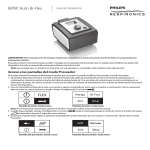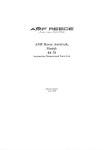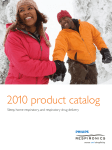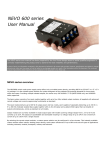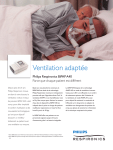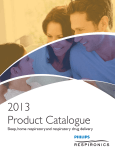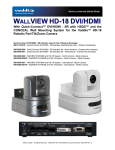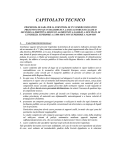Download Interpretation guide for Encore software compliance reports
Transcript
© goodluz - Fotolia.com Interpretation guide for Encore software compliance reports BiPAP AVAPS - BiPAP S/T BiPAP A30 - BiPAP A40 Allies in Better Sleep and Breathing . Table of Contents Philips Home Healthcare Solutions - Ventilation p 5 Definitions p 7 Interpretation of Encore software compliance reports p 14 Practical cases p 40 InTErPrETATIon guIdE for EnCorE SofTWArE ComPlIAnCE rEPorTS 3 Commitment to compliance our goal is to provide the best treatment solutions for your patients thanks to an advanced technology that is easy to use and helps customize follow-up. Clinically validated treatment solutions The Philips Commitment to Compliance Philips Home Healthcare Solutions Philips Home Healthcare Solutions - Ventilation Ventilation: -- Severe / Dependant ++ NMD, ALS, Pediatric (day and night) Overlap, COPD, OHS (night) CA E70 BiPAP A40 digital Auto-Trak AVAPS-AE Technology BiPAP A30 BiPAP AVAPS BiPAP S/T digital Auto-Trak AVAPS Technology Cough-Trak oscillations Technology Trilogy 100/200 digital Auto-Trak Technology AVAPS-AE digital Auto-Trak AVAPS Technology digital Auto-Trak * not available in all countries EncorePro and EncoreAnywhere DirectView Oximetry our Auto-Trak and AVAPS technologies, clinically validated for several years, are in most of our ventilation devices. Their purpose is to support the quality and comfort of ventilation, in order to ensure patient compliance. This is our commitment to compliance. InTErPrETATIon guIdE for EnCorE SofTWArE ComPlIAnCE rEPorTS 5 Philips Home Healthcare Solutions - Ventilation Validated: digital Auto-Trak and AVAPS Digital Auto-Trak The estimation of unintentional leaks is of major importance when monitoring NIV1; this also involves optimal synchronization of the patient-machine interface.2 It is with this commitment to quality that Digital Auto-Trak meets these criteria: •Simplifiedsettings,sincetherearenotriggersettings •Mechanical ventilation synchronized with the patient and not affected by leaks •Clinically validated algorithm • Effective ventilation: Digital Auto-Trak - A precise estimate of leaks and of Vte at +/- 15% - Compensation of leaks above 60 LPM •Digital Auto-Trak is available on all machines in the Philips non-invasive ventilation range AVAPS: Average Volume Assured Pressure Support* IthasbeendemonstratedduringBi-levelventilationwithaleakingmaskthatbyprovidingatargetvolume,itispossibleto improve the quality of ventilation.3,4 ThisisthereasonfortheAVAPSfunction,whichadjustsassistedpressureautomaticallydependingontheneedsofpatients. •Facilitates titration: no adjustment of IPAP •Tracks the progression of the disease and the changing ventilation needs of patients AVAPS •Improvesventilation:efficacyandcomfort •Increasedsafety:guaranteedaveragevolume,alarmsforVteandminuteventilation new AVAPS*-AE ventilation mode ThisnewmodecombinestheefficacyoftheAVAPSfunctionwith •Adjustment of expiratory pressure based on an algorithm for measuring the resistances of upper airways. •Automatic setting of the target respiratory frequency night after night. The purpose of this mode is to ensure effective and comfortable ventilation for the patient. AVAPS-AE Reason: •29% to 40% of COPD patients have an OSA5 •90% of those with OHS have an OSA6 * AVAPS: Average Volume Assured Pressure Support mode 1 Contal, Chest, 2011: “monitoring of nIV by built-in software of home bilevel ventilators: a bench study” 2 Battisti, Chest, 2005: “Performance Characteristics of 10 Home mechanical Ventilators in Pressure-Support mode” 3 murphy, Thorax, 2012: “Volume targeted versus pressure support non-invasive ventilation in patients with super obesity and chronic respiratory failure: a randomised controlled trial” 4 Storre et al. Chest 2006; 130: 815-821 5 Jelic International Journal of CoPd 2008: 3(2)269-275 6 mohklesi. Chest 2007:131;1624-1626 6 InTErPrETATIon guIdE for EnCorE SofTWArE ComPlIAnCE rEPorTS Definitions Definitions InTErPrETATIon guIdE for EnCorE SofTWArE ComPlIAnCE rEPorTS 7 Definitions Definitions of detected events Understanding how the machine functions Advanced detection of events Nocturnalbreathingdisorders,suchasapneas,hypopneas, RERA,snoringandCheyne-Stokesrespiration,aredetected depending on the devices. Devices can also distinguish between open or closed airway sleep apneas. Apnea (OSA or CSA): Absence or reduction by at least 80%ofpatientairflowforatleast10seconds.Whenthe machinedetectsanevent,itteststhepatient’sairwayduring the tested breathing cycle: 1.Ifnoairflowisgeneratedbytheventilation:theairwaysare obstructed 2.Ifairflowisgeneratedbytheventilation:theairwaysare open Comment: InSpontaneousmodeorPPC,detectionofeventsisthesame as that for sleep therapy devices. Hypopnea (H):Definedbya40%reductioninairflowforat least 10 seconds. RERA: (RespiratoryEffortRelatedArousal) A sequence of breaths that exhibit both a subtle reduction in airlfow during a 10-second period and a progressive increase inflowlimitation.Ifabreathsequenceisterminatedbya suddenincreaseinairlfow(alongwitheliminationofflow limitation),aRERAisindicated. obstructed airway apnea open airway apnea Ifthetestcycleleadstoaflowgreaterthan80%,theapnea hasbeeneffectivelytreated,andnoeventisreported. The machine can test the airways several times during apnea until the patient starts breathing again spontaneously. Inthecaseofmixedapnea(startedbyacentralapnea,then finishingwitheffortsagain),theapneawillbequalifiedasOSA (ObstructiveSleepApnea). 8 Cheyne-Stokes Respiration (CSR): Period lasting 30 to 100 seconds of successive hypoventilation and hyperventilationcyclesthatrepeat.Thereductionofairflow duringhypoventilationmustbeatleast40%,andthisevent mustlastseveralminutesbeforebeingqualifiedasperiodic respiration. Vibratory Snoring (VS):Pressuresensoridentifies pressurefluctuationsthatoccurinairwayduringinspiration. InTErPrETATIon guIdE for EnCorE SofTWArE ComPlIAnCE rEPorTS Definitions How to read and interpret leak information It is essential to detect and resolve unintentional leaks caused by a poor mask seal or mouth leak.These leaks, if large and regular, can affect treatment efficacy and lead to significant discomfort for the patient. Definitionofleaks: unintentional (or involuntary) leaks + Intentional (or voluntary) leaks = Total leaks Intentional leaks: leaks caused by the mask exhalation port. Intentional leaks vary according to the level of pressure applied. Unintentional leaks: leaks around the mask resulting from apoormasksealormouthleakduetothepatient’smouth opening while sleeping. Total leaks: intentional leaks + unintentional leaks. Leaks are expressed in litres/minute. Data available on leaks Display of total leaks/unintentional leaks TheEncoresoftware(Entityparametertab/parameterworksheet)allowsyoutochoosebetweendisplayingtotalleaksor unintentionalleaks,excludingintentionalmaskleaksforeachpressurepoint.Theunintentionalleakdisplayallowsforfast identificationofaproblemwithmasksealormouthleak. InTErPrETATIon guIdE for EnCorE SofTWArE ComPlIAnCE rEPorTS 9 Definitions Large leak alert during the night This algorithm was developed to tolerate leaks and to compensateforthemuptoacertainlevel.Beyondthatlevel, the analysis of the respiration may no longer be accurate and that is why the algorithm indicates the area of large leaks. These periods are indicated by black or light green bars depending on the machine model and version of the Encore software. The percentage of the night spent with large leaks is indicated in the reports. Note It is recommended to resolve the problem of mask leaks if there are more than 5% of large leaks during the night. Interpretation of the report should take into consideration that the patient is not being treated properly by the machine during these periods of large leaks. Detecting mouthpiece leaks There is a suspicion of mouthpiece leaks when the unintentional(orunplanned)leakprofileisshadedand unstableandwhentherearenolargeleaks,asbelow. Machine management of leaks: Digital Auto-Trak Philips Respironics machines use an advanced algorithm regarding leak tolerability and compensation: Digital AutoTrak.1Thistechnologyallows,atalltimes,forthemachine tosaveareliableandprecisereadingofpatientairflow,for unintentionalandvariableairflowduringthenight.This guarantees delivery of the set pressures and AVAPS by the machine,aswellastheefficacyofdetectionalgorithmsfor respiratory events. Philips Respironics machines tolerate up to 2 times the intentional leaks. They compensate for these leaks by adjusting theblowerspeed.Beyondtheleveloftolerability,themachine indicates that its detection is no longer reliable because of the highlevelunintentionalleaks(=periodoflargeleaks).During periodsoflargeleaks,ventilationisensuredthankstothe back-up rate. Period of large leaks Total leak tolerability threshold 100 Leak (L/min) 80 Leak compensation tolerability area 60 40 20 0 Philips Respironics average intentional leak profile 4 10,0 15,0 Pressure (cmH2O) 20,0 1 Contal, Chest, 2011: “Monitoring of NI V by built-in software of home bilevel ventilators: a bench study” 10 InTErPrETATIon guIdE for EnCorE SofTWArE ComPlIAnCE rEPorTS Definitions The ventilation modes In BiPAP S/T, BiPAP AVAPS, BiPAP A30 and BiPAP A40, pressure ventilation modes are used. What differentiates these modes is the autonomy given to the patient on whether or not to trigger the respiratory cycles or stop them. Pressure modes: S: S/T: Spontaneous: the respiration cycles are triggered and checked by the patient. Spontaneous/Timed:similartothespontaneousmode,withtheabilityforcyclestriggeredandcontrolledbythe unit,startingfromadefinedrateandinspiratorytime PC: PressureControl:thebreathsaretriggeredbythepatientorbythedevice,andcontrolledbythedevice. The length of the breath is determined by the inspiratory time setting. T: Timed:therespirationcyclesaretriggeredandcontrolledbythedevice,breathingrateofthepatienthasno effectonthedevice’sbreathrate. AVAPS-AE: AVAPS-AEbreathscanbetriggeredandcontrolledbythepatient,withtheabilityforbreathstobetriggered andcontrolledbythedevicefromabreathrateandinspiratorytimedefinedautomaticallybytheunit. S mode: S/T mode: PC mode: T mode: InTErPrETATIon guIdE for EnCorE SofTWArE ComPlIAnCE rEPorTS 11 Definitions AVAPS-AE mode: The AVAPS-AE mode is the only mode combining aguaranteedtidalvolume,avariationofexhalation pressure to overcome the resistance of the upper airways,andaback-upratecalculatedfromthe patient’sbreathing. Conversion tables: Conversion table to set the inspiratory time for controlled breaths Set back-up rate (BPM) 10 11 12 13 14 15 16 17 18 19 20 21 22 23 24 25 I/E 1/3,Ti/Ttot 25% 1.5 sec. 1.4sec. 1.3 sec. 1.2 sec. 1.1 sec. 1.0 sec. 0.9 sec. 0.9 sec. 0.8 sec. 0.8 sec. 0.8 sec. 0.7 sec. 0.7 sec. 0.7 sec. 0.6 sec. 0.6 sec. I/E 1/2 Ti/Ttot 33% 2.0 sec. 1.8 sec. 1.7 sec. 1.5 sec. 1.4sec. 1.3 sec. 1.3 sec. 1.2 sec. 1.1 sec. 1.1 sec. 1.0 sec. 1.0 sec. 0.9 sec. 0.9 sec. 0.8 sec. 0.8 sec. I/E 1/1 Ti/Ttot 50% 3.0 sec. 2.7 sec. 2.5 sec. 2.3 sec. 2.1 sec. 2.0 sec. 1.8 sec. 1.7 sec. 1.6 sec. 1.5 sec. 1.5 sec. 1.4sec. 1.3 sec. 1.3 sec. 1.2 sec. 1.2 sec. Set the inspiratory time in seconds: Ti (sec) = 60/breathing rate x % Ti 12 InTErPrETATIon guIdE for EnCorE SofTWArE ComPlIAnCE rEPorTS Definitions Conversion tables: (cont.) Conversion table to set the target tidal volume in relation to the ideal weight Height 1.50 m 1.55 m 1.60 m 1.65 m 1.70 m 1.75 m 1.80 m 1.85 m 1.90 m Calculated ideal weight (when BMI = 23) 52.0 kg 55.0 kg 59.0 kg 62.5 kg 66.5 kg 70.5 kg 74.5kg 78.5 kg 83.0 kg Target Vte if 8 ml/kg Target Vte if 10 ml/kg 410mL 440mL 470mL 500 mL 530 mL 560 mL 600 mL 630 mL 660 mL 520 mL 550 mL 590 mL 620 mL 660 mL 700 mL 740mL 780 mL 830 mL Calculated with an ideal body mass index of 23 kg/m2 (BmI = weight/height2) InTErPrETATIon guIdE for EnCorE SofTWArE ComPlIAnCE rEPorTS 13 Interpretation of Encore software compliance reports data reading methodology 1 Compliance: a. Is overall compliance satisfactory? b.Whatistheratiobetweenthenumberoftherapyhoursversusthenumberofpatient sleep hours? c.Whatdoestheusageprofileteachus?Iscompliancecontinuousandregular? Is there napping? 2 Leaks: a. Is the average % of the night spent with large leaks higher than 5%? Every night? b. Are mouth leaks suspected? 3 Volume: a. Is it normal? b.IftheAVAPSisactivated,istheaveragetidalvolumeclosetothesettargetvolume? c.Whatisthestabilityatthisvolume? d.Howhasthetidalvolumebeenset?8to10mL/kg,dependingontheheightandthe theoretical weight of the patient. 4 Pressures: a. Are they equal to the prescribed pressures? b.IftheAVAPSisactivated,doestheaverageinspiratorypressurevarybetweentheIPAP min and max? c. Is this the same for the average expiratory pressure in the AVAPS-AE mode? 5 Ventilation-minutes: a. Are they normal? b.Dotheycorrespondtothepatient’sneeds(adjustedvolumeandfrequency)? 14 InTErPrETATIon guIdE for EnCorE SofTWArE ComPlIAnCE rEPorTS Interpretation of Encore software compliance reports InTErPrETATIon guIdE for EnCorE SofTWArE ComPlIAnCE rEPorTS 15 Interpretation of Encore software compliance reports Patient compliance and pressure profile BiPAP AVAPS Patient name and machine Machine detail Name, serial number Patient information Period covered by the report Ventilation mode with the AVAPS function Compliance duration for the nights of insufficient use are reported in red note: this parameter can be personalized in the Encore software Inspiratory and expiratory pressure during treatment 16 InTErPrETATIon guIdE for EnCorE SofTWArE ComPlIAnCE rEPorTS Patient name and machine Machine detail Name, serial number Patient information Interpretation of Encore software compliance reports BiPAP A30 Period covered by the report Humidifier settings if it is attached to the machine Ventilation mode used Length of compliance per night Nights of insufficient use (under the set threshold) are indicated in red note: this parameter can be customized in the Encore software. Pressure profile IPAP Inspiratory Pressure EPAP Expiratory Pressure Pressure Support (PS) profile PS = IPAP - EPAP note: use of the AVAPS function allows a variation of PS over time Apnea-hypopnea index (AHI) Average AHI over the selected period IPAP 90 corresponds to IPAP delivered for 90% of the night EPAP 90 corresponds to EPAP delivered for 90% of the night; the pressure is set here InTErPrETATIon guIdE for EnCorE SofTWArE ComPlIAnCE rEPorTS 17 Interpretation of Encore software compliance reports Usage profile: Profile usage: daily compliance Note: the profile provides a first idea about the patient’s behavior regarding therapy. Irregular and insufficient compliance indicates difficulties the patient is encountering, and/or a lack of motivation. The nights in green indicate that compliance time is sufficient; those in red indicate that the patient is not sufficiently compliant. The 1st number represents the number of real compliance hours, the 2nd number is that of blower hours (ventilation is functioning but without detecting the patient’s breathing) Green: Blower functioning, patient breathing detected White: Blower stopped Black: Blower functioning, but without detecting breaths note: activation of the machine’s automatic start/stop prevents the blower from functioning without being connected to the patient 18 InTErPrETATIon guIdE for EnCorE SofTWArE ComPlIAnCE rEPorTS Patient name and machine Machine detail Name, serial number Patient information Interpretation of Encore software compliance reports BiPAP A40 Period covered by the report Humidifier settings if it is attached to the machine Ventilation mode used Length of compliance per night. Nights of insufficient use (under the set threshold) are indicated in red note: this parameter can be customized in the Encore software. Pressure profile IPAP Inspiratory Pressure EPAP Expiratory Pressure note: AVAPS-AE allows for a variation of EPAP over time Pressure Support (PS) profile PS = IPAP - EPAP note: AVAPS allows for a variation of PS over time Apnea-hypopnea index (AHI) Average AHI over the selected period IPAP 90 corresponds to IPAP delivered for 90% of the night EPAP 90 corresponds to EPAP delivered for 90% of the night InTErPrETATIon guIdE for EnCorE SofTWArE ComPlIAnCE rEPorTS 19 Interpretation of Encore software compliance reports 20 long-term BiPAP AVAPS trends InTErPrETATIon guIdE for EnCorE SofTWArE ComPlIAnCE rEPorTS Average inspiratory and expiratory pressure over the period Note: Variation in the inspiratory pressure may indicate the activation of the AVAPS function, or modification of the parameter. Interpretation of Encore software compliance reports Period involved in the long-term trend.This period can be modified using the Encore software Average respiratory frequency over the period Average tidal volume for the period note: If the AVAPS is activated, this value makes it possible to check whether the set volume is being met. Average percentage of breaths triggered by the patient note: The lower the percentage, the more the machine initiates the breaths. This makes it possible to know the percentage of time spent in machine-initiated cycles. Average maximum flow over the period in litres/minute Average leakage over the period in litres/minute Average minute ventilation over the period in litres/minute Average Apnea-Hypopnea Indices over the period note: AHI counts the number of Apneas (with and without obstruction), and the Hypopneas per hour. InTErPrETATIon guIdE for EnCorE SofTWArE ComPlIAnCE rEPorTS 21 Interpretation of Encore software compliance reports 22 long-term BiPAP A30 1/2 trends InTErPrETATIon guIdE for EnCorE SofTWArE ComPlIAnCE rEPorTS Period involved in the long-term trend.This period can be modified using the Encore software Average inspiratory and expiratory pressure over the period Note: Variation in the inspiratory pressure indicates the activation of the AVAPS function, or modification of the parameter. Expiratory pressure also varies with an A40 and the AVAPS-AE mode. Interpretation of Encore software compliance reports Patient name and machine Average respiratory frequency over the period Average tidal volume for the period note: If the AVAPS is activated, this value makes it possible to check whether the set volume is being met Average percentage of breaths triggered by the patient note: The lower the percentage, the more the machine initiates the breaths. This makes it possible to know the percentage of time spent in machine-initiated cycles. Average leakage in litres/minute Average minute ventilation over the period in litres/minute Average Apnea-Hypopnea Indices over the period note: AHI counts the number of apneas (with and without obstruction), and the hypopneas per hour. InTErPrETATIon guIdE for EnCorE SofTWArE ComPlIAnCE rEPorTS 23 Interpretation of Encore software compliance reports long-term BiPAP A30 2/2 trends The long term trends show the patient’s progression For example, an unstable average tidal volume may indicate a changed ventilation quality 24 InTErPrETATIon guIdE for EnCorE SofTWArE ComPlIAnCE rEPorTS Interpretation of Encore software compliance reports Average clear airway apnea index (CA) over the period Average obstructive airway apnea index (OA) over the period Average hypopnea (H) index over the period Average RERA (RE) index over the period Vibratory snoring (VS) index over the period Average percentage of the night spent with large leaks during the period Note: In this example, the percentage during the first nights in February 2012 was too high for the ventilation to be effective. The issue was obviously resolved, and there were a few episodes of large leakage only during a few nights InTErPrETATIon guIdE for EnCorE SofTWArE ComPlIAnCE rEPorTS 25 Interpretation of Encore software compliance reports 26 long-term BiPAP A40 1/2 trends InTErPrETATIon guIdE for EnCorE SofTWArE ComPlIAnCE rEPorTS Period involved in the long-term trend.This period can be modified using the Encore software Average inspiratory and expiratory pressure over the period note: Activation of the AVAPS-AE mode allows a variation of inspiratory and expiratory pressure. Interpretation of Encore software compliance reports Patient name and machine Average respiratory frequency over the period note: Automatic respiratory frequency allows a safety frequency closer to the spontaneous respiration of the patient. Average tidal volume for the period note: This value makes it possible to check whether the set volume is being met. Average percentage of breaths triggered by the patient note: The lower the percentage, the more the machine initiates the breaths. This makes it possible to know the percentage of time spent in machine-initiated cycles. Average leakage in litres/minute Average minute ventilation over the period in litres/minute Average Apnea-Hypopnea Indices over the period note: AHI counts the number of apneas (with and without obstruction), and the hypopneas per hour. InTErPrETATIon guIdE for EnCorE SofTWArE ComPlIAnCE rEPorTS 27 Interpretation of Encore software compliance reports long-term BiPAP A40 2/2 trends The long-term trends show the patient’s progression For example, an unstable average tidal volume may indicate a changed ventilation quality 28 InTErPrETATIon guIdE for EnCorE SofTWArE ComPlIAnCE rEPorTS Average obstructive apnea index (OA) over the period Interpretation of Encore software compliance reports Average clear airway apnea index (CA) over the period Average hypopnea (H) index over the period Average RERA (RE) index over the period Vibratory snoring (VS) index over the period Average percentage of the night spent with large leaks during the period Note: In this example, a large leak occurred one night. This large leak is reflected in the analysis of other data from the report. InTErPrETATIon guIdE for EnCorE SofTWArE ComPlIAnCE rEPorTS 29 Interpretation of Encore software compliance reports 30 daily BiPAP AVAPS details InTErPrETATIon guIdE for EnCorE SofTWArE ComPlIAnCE rEPorTS Profile for the day’s inspiratory and expiratory pressures note: Variation in the inspiratory pressure may indicate the activation of the AVAPS function. Interpretation of Encore software compliance reports Day involved Average respiratory frequency for the day Average tidal volume for the day note: If the AVAPS is activated, this value makes it possible to check whether the set volume is being met. Average percentage of breaths triggered by the patient note: The lower the percentage is, the more the machine initiates the breaths. This makes it possible to know the percentage of time spent in machine initiated cycles. Average leakage in litres/minute for the day Average ventilation-minutes for the day in litres/minute Ventilator alarms that occurred during the day InTErPrETATIon guIdE for EnCorE SofTWArE ComPlIAnCE rEPorTS 31 Interpretation of Encore software compliance reports 32 daily BiPAP 30 details InTErPrETATIon guIdE for EnCorE SofTWArE ComPlIAnCE rEPorTS Profile for the day’s inspiratory and expiratory pressures note: Here we see that the AVAPS function has been activated, because the inspiratory pressure varies widely to maintain the target volume. Interpretation of Encore software compliance reports Day involved and treatment start time Average respiratory frequency for the day Average and tidal volume for the day note: If the AVAPS is activated, this value makes it possible to check whether the set volume is being met. Average percentage of respirations triggered by the patient note: A percentage close to zero indicates that the patient is resting over the set safety frequency, or that this frequency is set too high. Index for sleep events note: Indices can be correlated with ventilator data. Unintentional leak profile during the course of the day note: Here we can choose to have the total leaks displayed instead of unintentional leaks (can be configured in Encore software). The color code and legend make it possible to verify the mask’s seal in the blink of an eye. Average ventilation-minutes for the day in litres/minute Ventilator alarms that occurred during the day InTErPrETATIon guIdE for EnCorE SofTWArE ComPlIAnCE rEPorTS 33 Interpretation of Encore software compliance reports 34 daily BiPAP 40 details InTErPrETATIon guIdE for EnCorE SofTWArE ComPlIAnCE rEPorTS Profiles for the day’s inspiratory and expiratory pressures note: Here we see that the AVAPS-AE mode has been activated, because the inspiratory pressure varies to maintain the target volume, and the expiratory pressure to raise resistances. Interpretation of Encore software compliance reports Day involved and treatment start time Average respiratory frequency for the day Average and tidal volume for the day note: This value makes it possible to check whether the set volume is being met. Average percentage of respirations triggered by the patient note: A percentage close to zero indicates that the patient is resting over the set back-up rate. Index for sleep events note: Indices can be correlated with ventilator data. Unintentional leak profile during the course of the day note: Here we can choose to have the total leaks displayed instead of unintentional leaks (can be configured in Encore software). The color code and legend make it possible to verify the mask’s seal in the blink of an eye. Average minute ventilation for the day in litres/minute Ventilator alarms that occurred during the day InTErPrETATIon guIdE for EnCorE SofTWArE ComPlIAnCE rEPorTS 35 Interpretation of Encore software compliance reports 36 oximetry data InTErPrETATIon guIdE for EnCorE SofTWArE ComPlIAnCE rEPorTS Interpretation of Encore software compliance reports Oxygen saturation profile for the day concerned Spo2 saturation curve in % note: The low Saturation (lS) threshold can be set in Encore software. It is 88% by default. desaturation periods are displayed in yellow. desaturations can be correlated with ventilator data and benchmarks from the sleep treatment. The oxygen desaturation index represents the number of desaturation events per hour of treatment A desaturation event is defined as a reduction of SpO2 of 4% or more over a window of less than 2 minutes note: If the patient desaturates several times during a window of 2 minutes, all events will be reported each time the reduction of Spo2 is greater than or equal to 4%. However, a slow and progressive desaturation that takes more than 2 minutes to reach at least a 4% reduction will not be counted as a desaturation event. Average SpO2 of the night Average heart rate of the night Graphic chart representing the percentages and real time of the night spent in different levels of oxygen saturation Maximum, minimum and average values of SpO2 and heart rate during the night Low saturation (LS) = an oxygen saturation threshold of less than or equal to 88% This low saturation threshold can be customized in the Encore software (tab > calculation parameters). InTErPrETATIon guIdE for EnCorE SofTWArE ComPlIAnCE rEPorTS 37 Interpretation of Encore software compliance reports 38 Statistics, compliance summary and settings InTErPrETATIon guIdE for EnCorE SofTWArE ComPlIAnCE rEPorTS Interpretation of Encore software compliance reports Statistical data Data can be displayed by day, week, month (opposite) and quarter note: This information makes it possible to observe the evolution of ventilator data and to appraise the patient’s stability. Real usage, meaning the total compliance over the entire treatment period of the report Note: In this example, the real usage figures and blower usage are identical. This indicates that the machine properly detected the patient breathing during the entire treatment period (absence of patient disconnection). Days of usage over 4 hours note: It is possible to modify the minimum compliance level in Encore softwares (Preferences). Blower usage Primary parameters settings note: Settings correspond to the last parameters set on the ventilator during downloading. note: These settings are displayed by the BiPAP A30 and BiPAP A40. AVAPS air flow represents the variation speed of pressure in cmH2o/min to reach the target volume. InTErPrETATIon guIdE for EnCorE SofTWArE ComPlIAnCE rEPorTS 39 Practical cases Practical case 1: 1. Compliance check The patient is ventilated with a BiPAP A30 in S/T mode. He appears compliant. Ventilation is more fragmented; some areas of respiration non-detection (blackareas)appearmoreandmore. Theusageprofileisregular, the lengths of ventilation are consistent. 2. Check for leaks a Through trends The average total leakage is acceptable. Buttheleakageprofileiscompletelychaotic. b Through daily details Throughthedailydetails,theleaks(unintentional) are much too large. Leaks are present throughout the night. Recommendation: There is no use in continuing the analysis of this report since the level of leaks is too high. Before modifying any of the ventilationparameters,itisimperativetofindthecauseoftheleaks.Itisadvisabletoreviewtheplacementandtheseal of the interface with the patient. 40 InTErPrETATIon guIdE for EnCorE SofTWArE ComPlIAnCE rEPorTS Practical cases Practical case 2: 1. Compliance and settings check The patient is ventilated with a BiPAP A30 in S/T mode. He seems very compliant. InTErPrETATIon guIdE for EnCorE SofTWArE ComPlIAnCE rEPorTS 41 Practical cases 2. Check for leaks a Through trends b Through the daily details (through on of the last days of the period) The leaks (total through the trends and unintentional leaks in the daily detailsinthisexample)arestableand very acceptable. 3. Check of the ventilator data a Through trends There is nothing particular to report through the trends; the parameters are correct. The machine is properly delivering thesetfixed pressures,the patient triggers the cycles spontaneously the majority of thetime,and ventilation-minutes are correct. It was noted that the leaks may be causing the pressure delivered to the patient to fall slightly. 42 InTErPrETATIon guIdE for EnCorE SofTWArE ComPlIAnCE rEPorTS Practical cases b Through daily details Throughthedailydetails,wecansee that the volume curve is extremely variable,thetidalvolumetakenby the patient often varies from one to twotimesinafewhours,whilethe average tidal volume over the entire night is correct. Thesamesignificantvariationsin tidal volume on the following nights. Recommendation: Whenthefixedpressuresareset,itisnormaltodetectthatthevolumeexhaledbythepatientvariesovertime,becausehis respiratorymechanics(complianceandresistance)variesalongwithhispositionandhissleepstages. Forthispatient,thedoctorwillprobablywanttoperformacheckonO2 saturation to make sure that these variations in tidal volume are not leading to periods of desaturation. Also,theactivationoftheAVAPSfunctionhasmadeitpossibletostabilizethevolume(settingofthetargettidalvolumebasedonthe patient’stheoreticalweight,certainly700mLaccordingtotheratio),sincetheventilatorcanbemadetovarytheinspiratorypressure inapressurewindowtobedetermined,inordertoguaranteethetargettidalvolume. InTErPrETATIon guIdE for EnCorE SofTWArE ComPlIAnCE rEPorTS 43 Practical cases Practical case 3: 1. Compliance and settings check ThepatientisventilatedwithaBiPAPAVAPSinS/T+AVAPSmode(informationreadonthe1stpageofthereport) Thismodewaschosentofacilitatetitrationandthestart-upofthetreatment.Datawascollectedafterthefirsttwonights of use. Thesettingsareasfollows:Insp.P.Max:20/Insp.P.Min.:15/Exp.P.5/Vt:420mL/Fr:13 Theusageprofileshowsusthatthefirstnightisbrokenupbyblackareas.Itcanbespeculatedthatthereare seal issues with the interface that affect the entire night. Iftheblackareawasinablockattheendofthepatient’snight,thismayhaveindicatedthatthepatienttookoff his mask upon waking up without turning off the machine. 44 InTErPrETATIon guIdE for EnCorE SofTWArE ComPlIAnCE rEPorTS Practical cases 2. Check for leaks a Through daily details Theleaksgraph(unintentionalleakshere)confirmswhatcouldhavebeenguessedfromtheblackareasseen onthepatient’scompliancegraph. Thefirstnightwasacatastropheintermsofleaks.Ventilationisfragmentedandineffective,interruptions in the trace are due to leaks: the machine is no longer detecting or recording. The machine is unable to compensate for these large leaks. Thesealproblemseemstohavebeenresolved,sincetheleaksduringthesecondnightareacceptableon the whole. InTErPrETATIon guIdE for EnCorE SofTWArE ComPlIAnCE rEPorTS 45 Practical cases 3. Check of the ventilator data a Through daily details Thepressureprofileresembles afixedpressuresprofilewhile the AVAPS function is activated. The inspiratory pressure does not vary in the set range(15-20),themachine is delivering a set pressure of 15 cmH2O. Ineffect,theVtecausedbythe min. Inspiratory P. of 15 cmH2O (582.1mLonaverage)isquite a bit higher than the target Vt setting(420mL). Therefore,themachineremains at the minimum Insp. P. for the entire night and the average tidalvolume(582.1mL)is higher than the target set (420mL).Thebenefitofthe AVAPS function is wasted. Recommendation: Thepatientappearswellventilated.Basedonbloodgases,andfeedbackfromthepatient,wecould: •Re-evaluatewhetherthetargetVtof420mLforthispatientissufficient. •Re-evaluatetheminimumInspiratoryPressuresothattheAVAPScanfunction(ifthetargetVtisleftat420mLthen 15asaMin.Insp.P.istoohigh). 46 InTErPrETATIon guIdE for EnCorE SofTWArE ComPlIAnCE rEPorTS Practical cases Practical case 4: 1. Compliance and settings check This patient is treated with a BiPAP AVAPS in S/T modeandbenefitsfromtheAVAPSfunction. Thepatientisstartingventilation,andaprogression in compliance can be detected. 2. Check for leaks Theleaksprofileisconstantlydecreasing.Thereisnoproblemtoreport. InTErPrETATIon guIdE for EnCorE SofTWArE ComPlIAnCE rEPorTS 47 Practical cases 3. Check of the ventilator data a Through trends The average tidal volume does not seem high; it would be worth knowing the height of the patient. Thepercentageofpatient-triggeredbreathsis30.1%, which means that the patient is triggering but is mostly receiving machine-triggered breaths. The AHI is too high. b Through daily details Thepressureprofileindicatesthatthemaximum inspiratory pressure is reached several times. Thebreathingrateprofileconfirmsthatthepatient is receiving machine-triggered breaths. The AHI shows a large number of apneas with or without obstructions. Recommendation: Severalrecommendationsarepossible,alwaysincoordinationwiththedoctor,andwithoneparameterchangedatatime: •Re-evaluatethetargetvolumebasedontheheightandtheoreticalweight,adjustingthepressurewindowand monitoring the report. •Verifythespontaneousbreathingrateatrestforthepatientinordertodeterminehisback-uprateandtomonitor within the report. •Adjusttheexpiratorypressurelevelbasedontheobstructivesleepapneaindex. 48 InTErPrETATIon guIdE for EnCorE SofTWArE ComPlIAnCE rEPorTS Notes InTErPrETATIon guIdE for EnCorE SofTWArE ComPlIAnCE rEPorTS 49 Notes 50 InTErPrETATIon guIdE for EnCorE SofTWArE ComPlIAnCE rEPorTS Notes InTErPrETATIon guIdE for EnCorE SofTWArE ComPlIAnCE rEPorTS 51 Philips Healthcare, a division of Royal Philips Contact information www.philips.com/healthcare [email protected] Asia +4970314632254 Philips Respironics 1010 Murry Ridge Lane Murrysville,PA15668USA Customer Service +17243874000 8003456443(tollfree,USandCanadaonly) Philips Respironics France +33 2 51 89 36 00 Europe,MiddleEast,Africa +4970314632254 Latin America +551121250744 Philips Respironics Switzerland +41627451750 www.philips.com/respironics North America +14254877000 8002855585(tollfree,USonly) Document meant for professionals. ClassIIaMD:TrueBlue,ComfortGelBlue,ProfileLite,EasyLife,Amara,ComfortGelBlueFull,FitLife,OptiLife,andComfortLitearemeantasapatient interface for the application of a PCP therapy, or with bi-level pressure for non-invasive ventilation, as prescribed by a doctor. Class IIb MD: PR1 BiPAPS/T,PR1BiPAPAVAPS,BiPAPA30,andBiPAPA40areventilationdevicesmeanttoprovideventilationsupporttotreatpatientssufferingfrom respiratory impairment or respiratory failure. These MDs are subject to reimbursement by health insurance organizations in certain situations; consult thetermsattheameli.frwebsite.TheseMDsareregulatedhealthproducts,andhavetheCEmarkforthisregulation,andtheevaluationoftheir compliance was performed by TÜV. Please carefully read the user manual that accompanies each medical device for any information related to its intended use and operation. The practical cases of this guide are presented for illustrative purposes; the recommendations of these cases do not replace good clinical judgment Please visit www.philips.com ©2014KoninklijkePhilipsN.V. All rights reserved. PhilipsHealthcarereservestherighttomakeanychangetothespecificationsand/ortostopproductionofanyproductatanytimeandwithout priornotice,andcannotbeheldresponsibleforanyconsequenceofusingthispublication. BroudyJA1/30/14MCI4105828PN1112802






















































